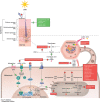Topical Treatments for Melasma and Their Mechanism of Action
- PMID: 35642229
- PMCID: PMC9122278
Topical Treatments for Melasma and Their Mechanism of Action
Abstract
Objective: We conducted a review of topical agents currently used in melasma, discussing their mechanism of action, efficacy, safety, and tolerability, with an update on newer treatments.
Methods: A systematic review from PubMed database was performed, using PRISMA guidelines. The search was limited to English and Spanish studies that were double or single blinded, prospective, controlled or randomized clinical trials, reviews of literature, and meta-analysis studies.
Results: 348 studies were analyzed; 80 papers met inclusion criteria. Triple combination (TC) therapy and hydroquinone (HQ) are still the most well-studied agents with strong evidence-based recommendation. TC therapy remains the gold standard of care based on efficacy and patient tolerability. Evidence has shown ascorbic acid, azelaic acid, glycolic acid, kojic acid, salicylic acid, and niacinamide to be effective as adjuvant therapies with minimal side effects. Tranexamic acid (TA) and cysteamine have become recent agents of interest due to their good tolerability, however more trials and studies are warranted. Less evidence exists for other topical agents, such as linoleic acid, mulberry extract oil, rucinol, 2% undecylenoyl phenylalanine, and epidermal growth factors agents.
Limitations: Some studies discussed represented a low sample size, and there is an overall lack of recent studies with larger populations and long-term follow up.
Conclusions: TC therapy continues to be the gold standard of care. Topical cysteamine and TA are newer options that can be incorporated as adjuvant and maintenance treatments into a patient's regimen. Cysteamine and topical TA have no known severe adverse effects. Evidence comparing other topical adjuvant treatments to HQ, maintains HQ as the gold standard of care.
Keywords: chloasma; depigmentation; depigmented agents; melanosis; melasma; peels; skin-lightening agents; therapy; topicals.
Copyright © 2022. Matrix Medical Communications. All rights reserved.
Conflict of interest statement
DISCLOSURES: The authors report no conflicts of interest relavant to the content of this article.
Figures
References
-
- McKesey J, Tovar-Garza A, Pandya AG. Melasma Treatment: An Evidence-Based Review. Am J Clin Dermatol. 2020;21(2):173–225. Apr. - PubMed
-
- Vachiramon V, Suchonwanit P, Thadanipon K. Melasma in men. J Cosmet Dermatol. 2012;11(2):151–157. Jun. - PubMed
-
- Huerth KA, Hassan S, Callender VD. Therapeutic Insights in Melasma and Hyperpigmentation Management. J Drugs Dermatol. 2019;18(8):718–729. Aug 1. - PubMed
-
- Ortonne JP, Arellano I, Berneburg M et al. A global survey of the role of ultraviolet radiation and hormonal influences in the development of melasma. J Eur Acad Dermatol Venereol. 2009;23(11):1254–1262. Nov. - PubMed
Publication types
LinkOut - more resources
Full Text Sources
Miscellaneous



